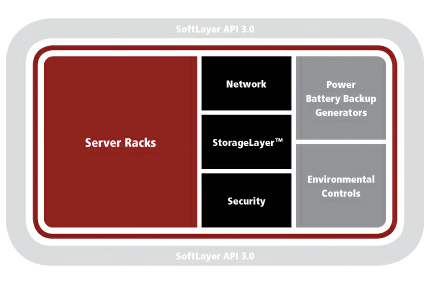Softlayer says it differentiates itself in the managed hosting market in several ways.
While the company will continue to play in the short term contract, monthly billing space it doesn’t see itself as a commodity managed services player. Yes, it provides capacity on demand and can talk about ‘multiple cloud provision’ or storage on demand from its broad menu of services.
But it believes it has key differentiators.
Firstly, the company owns a software platform with 2.6 million lines of code. Known as API 3.0 this is an application programming interface that gives developers and system administrators a direct line into SoftLayer's backend systems. The functionality allows remote server management, monitoring, and retrieve information from SoftLayer's various systems such as accounting, inventory and DNS. It can connect systems regardless of device or location including mobile devices such as a RIM Blackberry or Apple iPhone via a private network.
Secondly, it says, its customer base is very technically astute. The majority of its customers have a technical or web development background. They tend to develop their own apps.
Among its major corporate customers are Citrix and the social networking and blogging platform Tumblr runs its entire infrastructure in Softlayer data centers. Other key sectors for the company include games companies or media agencies with large content and digital delivery requirements.
Its customer base is large – 24,000-25,000 with many running just a couple of servers. But the commonality is that they are technology led being generally tech or web centric – development is typically a core competency.
This, the company says, maps nicely onto one of its own competencies, which is in its management layer. It provides server, storage and networking infrastructure beneath that.
Softlayer’s own infrastructure is primarily built on turn key data centers from Digital Realty Trust – typically running at 720kW.
Softlayer sees itself operating in the world where the virtualised public cloud is a very powerful model but not one that has obviated the need for large non-shared infrastructure. Bare metal infrastructure is needed and educated customers require non-standard architectures.
Softlayer knows that the managed hosting market is heavily populated but believes it has built a platform that is differentiated.
“Few people can provide virtual and physical infrastructure at the speed we can do,” says Simon West, chief marketing officer at the firm.
Its relationship with Citrix goes back to 2008 when it announced it would use and offer Citrix Xenserver as its hypervisor of choice to create a virtual hosted data center. It also announced the Citrix Cloud Center (C3) as a key cloud computing strategy platform.
The firm’s European HQ is in Amsterdam where it employs around 20 people. Its data center has capacity for more than 8,000 dedicated servers with 13MW of available input power.
Its list of partners includes Equinix, Abovenet, Level3, Comcast, Intel, Qwest and Rack Solutions.
Some key dates
The company was formed in 2005 in Dallas, Texas.
October 2011: Softlayer opens 48,000 DRT supplied Turnkey data center in Singapore
November 2010: Softlayer and The Planet merger announced as completed.
August 2010: Private Equity Firm GI Partners buys all outstanding equity in Softlayer. (GI invested in The Planet in 2006 and was an early DRT investor. It sold its stake in Telx in August 2011 to ABRY Partners and Berkshire Partners.)
July 12, 2010. Move to DRT owned site is completed and the company is now the sole occupant of 120,000 sq ft three-building complex located in North Dallas. Three new data center pods spanning the ground floor of the complex brought online.
February 2010: Softlayer announces move of Dallas HQ into Digital Realty owned building under a lease.
Softlayer’s infrastructure:
| Dallas | 104,500+ | Servers |
| Seattle | 10,000+ | Servers |
| Washington | 16,000+ | Servers |
| Houston | 25,000+ | Servers |
| San Jose | 12,000+ | Servers |
| Amsterdam | 8,000+ | Servers |
| Singapore | 16,000+ | Servers |

